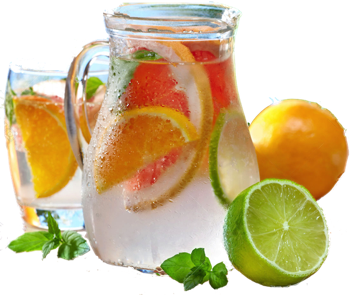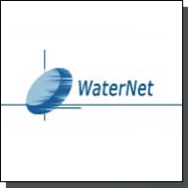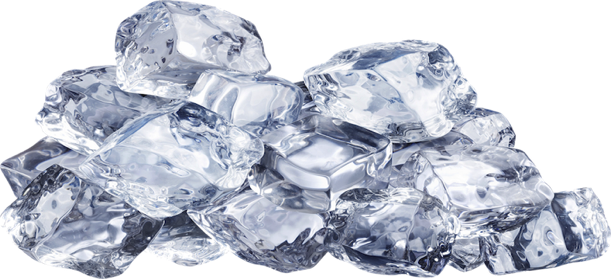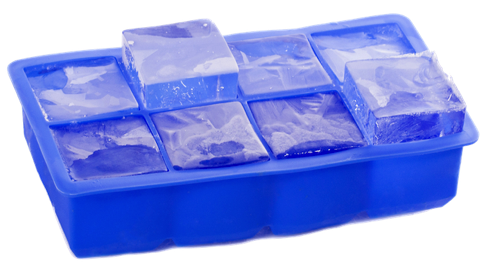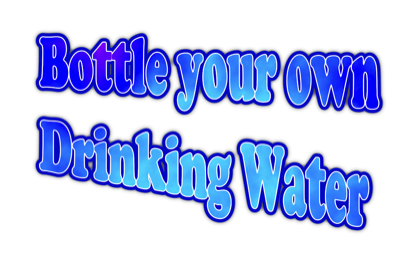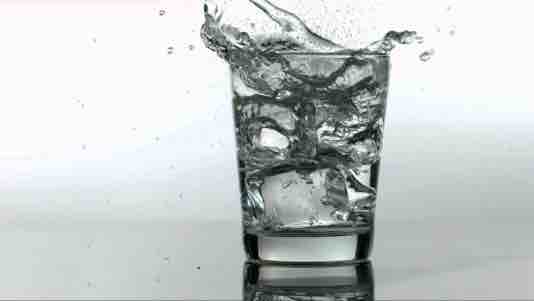What ARN water does
The E.A. water unit produces two kinds of water with different Redox potentials, one with a high reduction potential and the other with a high oxidation potential.
When taken internally, the reduced ARN water with its Redox potential of -250 to -350 mV readily donates its electrons to random oxygen radicals and blocks the interaction of the active oxygen with normal cells, which remains intact and undamaged.
Undamaged biological molecules are less susceptible to infection and disease. The ARN water gives up extra electrons and reduces the active oxygen, thus rendering it harmless. The active oxygen is reduced without damaging surrounding biological molecules. Substances, which have the ability to counteract active oxygen by supplying electrons, are called scavengers. ARN water, therefore, can be called scavenging water.
When taken internally, the effects of reduced water are immediate. ARN water inhibits excessive fermentation in the digestive tract by reducing indirect metabolites such as hydrogen sulphide, ammonia, amines, indoles, phenols and scatoles, resulting in a cleaner stool within days after ARN water is taken on a regular basis.
Today we read much about correct dieting principles and paying attention to what we eat in order to stay healthy. This is a sensible practice, but it is surprising that many of us don't realise that the bulk of what we eat is composed of water. Vegetables and fruits are 90% water, fish and meat are about 70% water as well.
Even advocates of the importance of vitamin C in diet have to admit that this vitamin is progressively lost from stored, and especially cooked foods.
ARN water, with its small cluster size and high reduction potential, makes it a superior scavenging agent for active oxygen. But electrolysis inside the ARN Water System not only charges the water with electrons; it also reduces the size of the water molecule clusters. NMR (nuclear magnetic resonance) analysis reveals that tap water and well water consists of clusters of 10 to 13 H20 molecules. Electrolysis of water in the E.A. Water System reduces these clusters to about half their normal size - 5 to 6 water molecules per cluster.
This is why the body more readily absorbs ARN water than untreated tap water. ARN water quickly permeates the body and blocks the oxidation of biological molecules by donating its abundant electrons to active oxygen, enabling biological molecules to replace themselves naturally without damage caused by oxidation that can cause diseases.
Although many people today in developed countries are becoming more particular about what they eat,
they tend to concentrate more on what the food contains rather than the metabolised products of foods in the digestive tract.
For example, consider the typical balanced diet of meat and vegetables. Meat protein is metabolised into amines while nitrates from fertilisers used to grow vegetables metabolise into nitrites in the digestive tract. These amines and nitrites combine to form nitrosamine, a recognised carcinogen.
We've already discussed that odoriferous faeces are evidence of excessive fermentation in the digestive tract, so ARN water performs a very important function upstream of the digestive tract by reducing this excessive fermentation as evidenced by cleaner stools within days of starting a steady regimen of ARN water.
Downstream from the digestive tract, starting at the liver, ARN water quickly enters the liver and other organs due to its lower molecular weight and the size of its clusters. At tissue sites throughout the body, ARN water with its safe, yet potent reduction potential readily donates its passenger electrons freely to active oxygen and neutralises them so they cannot damage the molecules of healthy cells. Normal cells are protected from the electron thievery of active oxygen and allowed to grow, mature; function and regenerate without interference from rogue oxygen radicals which tend to grab the electrons from the molecules of normal, healthy biological cells.
We are now in the midst of a water boom. In U.K. and other European countries consumers are buying various kinds of bottled water even though water is one of our most vital but abundant resource. Research data reveals that mineral waters have a Redox potential of +200 mV, slightly lower than the +400 mV measured for ordinary tap water. We can say that at least mineral water is marginally better than tap water from the viewpoint of Redox. Compared to any processed water for sale, however, ARN water with its reduction potential of -250 to -300 mV is beyond comparison due to its ability to scavenge active oxygen radicals.
How we can avoid illness
As mentioned earlier, the presence of toxic waste products imparts an offensive odour to human faeces.
In the medical profession it is well known that patients suffering from hepatitis and cirrhosis pass particularly odiferous stools.
There is no substitute for a natural and healthy balanced diet, one rich in antioxidant materials such as vitamin C, vitamin E, beta-carotene, and other foods that are good for us.
However water which is electro-activated (E.A.) to increase its reduction potential is a highly effective solution to the problem of providing a safe source of free electrons to block the oxidation of normal tissue by free oxygen radicals. We believe that this water called Activated Redox Negative water, with an excess of free electrons to donate to active oxygen, is more effective than special diets or vitamin supplements because it is so rapidly distributed throughout the body.
ARN water is the product of electrolysis, which takes place in the E.A. Water System. ARN water is treated tap water that has not only been filtered, but has also been restructured so that it has a high concentration of electrons which can neutralise excess active oxygen.
Tap water - What it is and isn't
Normal tap water, for example, with a pH of 7 is approximately neutral on the pH scale of 0 to 14. When measured with an ORP (oxidation/reduction potential) meter its redox potential is approximately +400 to +500 mV. Because it has a positive redox potential, it is apt to acquire electrons and oxidize other molecules. ARN water, on the other hand, has a negative redox potential of approximately -250 to -350 mV. This means it has a large mass of electrons ready to donate to electron grabbing active oxygen.
The pH of tap water is about pH 7 or neutral. When tap water, which usually has a high concentration of mineral salts, is electrolysed into ARN water, its reduced water has a pH of about 9 and the oxidised water a pH of about 4. Even if you make alkaline water of pH 9 by adding sodium hydroxide or make acidic water of pH 3 by adding hydrogen chloride, you will find very little change in the ORP values of the two waters. On the other hand, when the same tap water is treated with electrolysis you can see the ORP fluctuate by as much as 1,000 mV.
When tap water, with very low concentrations mineral salts or similar water produced by the Reverse Osmosis method, is electrolysed into ARN water, it has an improved negative potential without having a highly levitated pH. By electro-activation we can obtain reduced water with negative potential that is good for the body.
Traditionally we have judged the properties of water from the standpoint of pH, in other words whether water is acidic or alkaline. Redox potential is far more important than pH.
The importance of pH has been over-emphasised. For example, the average pH of blood is 7.4 and acidosis or alkalosis is defined according to deviation within the range of 7.4 + or - 0.05. But little has been discussed about oxidation-reduction potential (O.R.P. or redox potential).
Oxidation-Reduction Reactions
Basically, reduction means the addition of an electron (e-), and its converse, oxidation means the removal of an electron. The addition of an electron, reduction, stores energy in the reduced compound. The removal of an electron, oxidation, liberates energy from the oxidised compound. When one substance is reduced, another is oxidised.
To clarify these terms, consider any two molecules, A and B, for example.
Ae + B A + Be
Electron Electron ® Oxidised Reduced
Donor Receptor (lost an electron) (gained an electron)
In biological systems, removal or addition of an electron constitutes the most frequent mechanism of oxidation-reduction reactions. These oxidation-reduction reactions are frequently called redox reactions.
Acid & Bases
An acid is a substance that increases the concentration of hydrogen ions (H+) in water. A base is a substance that decreases the concentration of hydrogen ions, and simultaneously increases the concentration of hydroxyl ions (OH-).
What is pH?
The degree of acidity or alkalinity of a solution is measured in terms of a value known as pH which is the logarithm of the reciprocal of the concentration of hydrogen ions:
pH = log 1/(H+)
On the pH scale, which ranges from 0 on the acidic end to 14 on the alkaline end, a solution is neutral if its pH is 7. At pH 7, water contains equal concentrations of H+ and OH- ions. Substances with a pH less than 7 are acidic because they contain a higher concentration of H+ ions.
Substances with a pH higher than 7 are alkaline because they contain a higher concentration of OH- ions.
The pH scale is a log scale so a change of one pH unit means a tenfold change in the concentration of hydrogen ions.
The Importance of Balancing pH
Living things are extremely sensitive to pH and function best (with certain exceptions, such as certain portions of the digestive tract) when solutions are nearly neutral. Most living matter (excluding the cell nucleus) has a pH of about 6.8. Blood plasma and other fluids that surround the cells in the body have a pH of 7.2 to 7.3. Numerous special mechanisms aid in stabilising these fluids so that cells will not be subject to appreciable fluctuations in pH.
Substances, which stabilise pH, are called buffers. Buffers have the capacity to bond H and OH ions and remove them from solution whenever their concentration begins to rise. Conversely, buffers can release these ions whenever their concentration begins to fall. Buffers thus help to minimise the fluctuations in pH.
This is an important function because many biochemical reactions normally occurring in living organisms either release or take up ions.
Why we get sick?
Oxygen is essential to survival. In air it is in the diatomic form, O2, and is relatively stable in the air, but in the body small amounts of monatomic oxygen are produced. This is active, unstable and has a tendency to attach itself to any biological molecule, including molecules of healthy cells. The chemical activity of these free radicals is due to one or more unpaired electrons. About 2% of oxygen we normally breathe becomes active oxygen.
Such free radicals with unpaired electrons are highly active and have a high redox potential, which means they are capable of grabbing electrons from other cells. This chemical mechanism is very useful in disinfectants such as hydrogen peroxide and ozone, which can be used to sterilise wounds or medical instruments. These free radicals are produced inside the white cells, where they serve a useful function in killing bacteria, viruses, etc. Problems only arise when too many of these free radicals are turned loose in the body where they can also damage normal tissue.
Besides killing bacteria the reactive oxygen radicals are also of use in removing the products of putrefaction. Putrefaction sets in when microbes in the air degrade the proteins, peptides and amino acids of eggs, fish and meat. The result is an array of unpleasant substances such as,
Hydrogen sulphide, Ammonia, Amines, Indoles, Phenols, Scatoles. These substances are also produced naturally in the digestive tract when we digest food, resulting in the unpleasant odour of faeces. All these waste products of digestion are pathogenic; that is, they can cause disease in the body. Hydrogen sulphide and ammonia are toxins that can damage liver tissue. Amines contribute to disorders such as atopic dermatitis, urticaria (hives) and asthma.
Indoles and phenols are considered carcinogenic.
Because these waste products are toxic, the body's defence mechanisms try to eliminate them by releasing neutrophils a (type of leukocyte, or white corpuscle). The reactive oxygen produced by the neutrophils can neutralise these toxins.
Problems arise, however, when too many of these active oxygen molecules, or free radicals, are produced in the body. They are extremely reactive and can also attach themselves to normal, healthy cells and damage them genetically. These active oxygen radicals grab electrons from normal, healthy biological molecules. This electron 'grabbing' by active oxygen oxidises tissue and can cause disease.
Because active oxygen can damage normal tissue, it is essential to mop up or "scavenge" this active oxygen from the body before it can cause disintegration of healthy tissue. If we can find an effective method to block the oxidation of healthy tissue by active oxygen, then we can attempt to prevent disease.
One way to protect healthy tissue from the ravages of oxidation caused by active oxygen is to neutralise their high oxidation potential with free electrons.
Research on the link between diet and cancer is far from complete, but some evidence indicates that what we eat may affect our susceptibility to cancer. Some foods seem to help defend against cancer but others appear to promote it.
Much of the damage caused by carcinogenic substances in food may come about because of an oxidation reaction in the cell. In this process an oxygen molecule may damage the cell's genetic code. Many researchers believe that substances that prevent oxidation - called ANTIOXIDANTS - can block the damage. This leads naturally to the theory that the intake of natural antioxidants could be an important aspect of the body's defence against cancer. Substances thought to inhibit cancer include vitamin C, vitamin E, beta-carotene, Selenium and glutathione (an amino acid). These substances are reducing agents.
They supply electrons to free radicals and block the interaction of free radical with normal tissue.
Health Benefits | Waternet
Health Benefits of Electronically Restructured Water
Introduction
Role Activated Redox Negative Can Play In Chemistry of Life
Oxidation-Reduction Reactions
Acid & Bases
What is pH?
The Importance of Balancing pH
Why we get sick?
How we can avoid illness
Tap water - What it is and isn't
What ARN water does
Introduction
Every cell in the body is dependent for food and life upon the bloodstream, the "delivery system" that flows through the intricate system of blood vessels. The health of every cell in the body depends upon the freedom with which blood flows to it. Since blood is approximately 92% water, the right kind of water keeps the blood in its free flowing fluid state. It is the water in the blood that carries nutrients to the cells and the toxins away from the cells The right kind of water can assist the blood to do what it is intended to do.
The blood capillaries, although small and delicate, do not carry healing materials directly to the cells. Between the cells and the capillaries, there is a water-based fluid called lymph. No two cells of the body are ever in direct contact, the lymph surrounds, cleanses and bathes each cell. The capillaries drop their cargo of food and oxygen into the lymph and the cells pick these nutrients up as they float past. It is therefore very important that the lymph stream be kept fully and properly supplied with the right kind of water.
Dr Roy Walford of UCLA recently stated that our bodies should last a minimum of 120 years. This means that most people live less than two thirds of their potential life span. It is hypothesised that premature death and many symptoms of the ageing process may be due to an accumulation of toxins and free radicals in the cells of the body. These toxins are self generated by cellular metabolism and can also enter the body by the air we breathe, the food we eat and the liquids we drink.
This overload of toxic waste keeps our bodies from absorbing and utilising the nutrition, which our cells desperately need. If the blood is polluted and sluggish, it cannot transport vital substances to their destination. Research has shown that most people have blood streams that are extremely polluted.
Role Activated Redox Negative Can Play In Chemistry of Life
Water is a universal solvent due to the marked polarity of the water molecule and its tendency to form hydrogen bonds with other molecules. One water molecule expressed by the chemical symbol H20,
consists of 2 hydrogen atoms and 1 oxygen atom. Standing alone, the hydrogen atom contains 1 positive proton at its core with 1 negative electron revolving around it in a 3-dimensional shell.
The single hydrogen electron and the 8 electrons of oxygen are the key to the chemistry of life because this is where hydrogen and oxygen atoms combine to form a water molecule or split to form ions.
Water tends to ionise. When this happens one of the hydrogens donates its electron to the oxygen and separates off as an isolated proton. A covalent bond occurs when the electron of a hydrogen atom is shared with another electro-negative atom such as oxygen that needs another electron to complete the pair.
In a water molecule, 2 hydrogen atoms are thus covalently bonded to the oxygen atom. But because the oxygen atom is larger than the hydrogen, its attraction for the hydrogen's electrons is correspondingly greater. So, the electrons are drawn closer into the larger oxygen atom and away from the hydrogen atom. This gives the oxygen portions of the molecule a slight electro-negative charge, and the hydrogen portions correspondingly a slight positive charge. Because the oxygen end of the molecule is negative and the hydrogen ends are positive there is a tendency for water molecules form weak bonds with other water molecules.
These weak bonds, called hydrogen bonds, serve to link up all the molecules in a single portion of water. Without them it would be a gas at room temperature
Hydrogen bonds, which can also couple hydrogen to other atoms such as nitrogen, play a crucial role in stabilising the shape of many of the large molecules found in living matter. Because these bonds are weak, they are readily broken and reformed. In liquid water they break and reform 1011 times per second.
The disassembly and re-arrangement of such weak bonds is essential to the chemistry of life.
To illustrate water's ability to break down other substances, consider the simple example of putting a small amount of salt in a glass of tap water. With dry salt (NaCI) the attraction between the electropositive sodium (Na+) and electro-negative chlorine (Cl-) atoms of salt is very strong. But after salt is placed in water,
the attraction of the electro-negative oxygen of the water molecule for the positively charged sodium ions and the similar attraction of the electropositive hydrogen ends of the water molecule for the negatively charged chloride ions, are greater than the mutual attraction between the out-numbered Na+ and Cl- ions.
In water the ionic bonds of the sodium chloride molecule are thus broken easily because of the competitive action of the numerous water molecules.
As we can see from this simple example, even the delicate configuration of individual water molecules enables them to break relatively stronger bonds converging on them. This is why we call water the universal solvent. It is a natural solvent that breaks down some of the weaker bonds of larger, more complex molecules.
